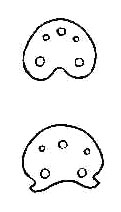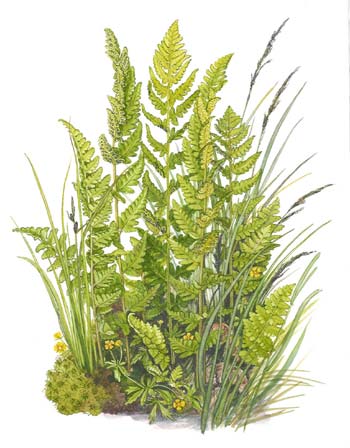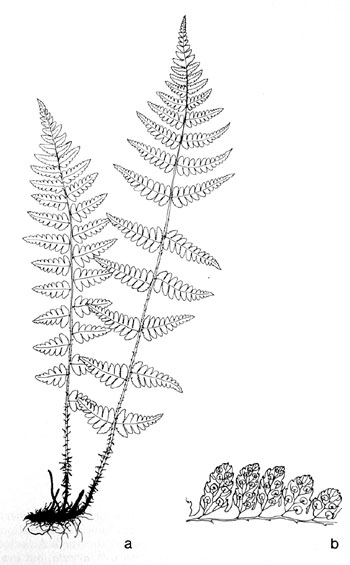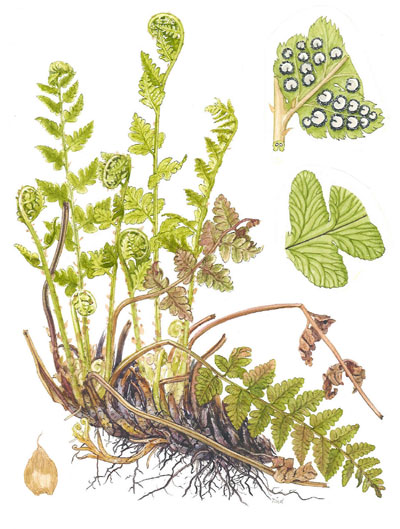| Dryopteris cristata | ||
Crested wood fern | ||
|
Etymology
cristata, Latin, like a comb. The fertile fronds have the pinnae twisted 90�, and thus appear comb-like in profile. The English common name is a mistranslation of the Latin.
Description
Rhizome: erect, massive, occasionally branching to form new crowns, covered with old stipe bases.
Frond: 60 cm high by 12 cm wide, fertile deciduous, sterile evergreen, dimorphic, fertile taller, erect, sterile fronds shorter, narrower at base, blade/stipe ratio: 2:1 to 3:1. Stipe: grooved, base swollen, persistent, scaly at the base, vascular bundles: 5 in a c-shaped pattern. Blade: 1-pinnate-pinnatifid, narrowly lanceolate or with parallel sides, herbaceous to somewhat leathery, linear to ovate scales below, absent above. Pinnae: 10 to 15 pair, isodromous, fertile pinnae twisted out of plane of blade, perpendicular to it, lower pinnae distant, triangular, upwards closer, narrower; pinnules oblong, rounded at the apex; costae grooved above, continuous from rachis to costae; margins spiny, serrate, bending slightly down; veins free, forked. Sori: round, in 1 row between midrib and margin, indusium: reniform, shriveling upon ripening, attached at a sinus, sporangia: dark brown, maturity: midsummer. Dimensionality: pinnae rotated 90� to a plane parallel to the ground. Culture
Habitat: swamps, swampy woods, or open shrubby wetlands .
Distribution: North America (mainly northern), Norway and England across northern and central Europe and northern Asia.
Hardy to -35�C, USDA Zone 3.
Synonyms
Polypodium cristatum L. Aspidium cristatum (L.) Swartz Nephrodium cristatum (L.) Michaux Filix cristata Farwell Lastrea cristata Presl Polystichum cristatum (L.) Roth |
|
|

Dryopteris cristata. Five vascular bundles at both the bottom (below) and the top of the stipe. Note, however, the change in the cross-section shape. �Drawing from Ferns of Northeastern United States, Farida A. Wiley, 1936. |

Dryopteris cristata. In habitat, Skalles�, Jutland, Denmark with Carex nigra, Potentilla erecta, Molinia coerulea, and Sphagnum sp. �Illustration from Scandinavian Ferns by Benjamin �llgaard and Kirsten Tind, Rhodos, 1993. |

Dryopteris cristata. a) fronds, sterile left (shorter, diminishing pinnae near base), fertile right; b) fertile pinnules. �Illustration by V. Fulford from Ferns and Fern Allies of Canada, William J. Cody and Donald M. Britton, 1989, � Agriculture Canada, used with permission. |
